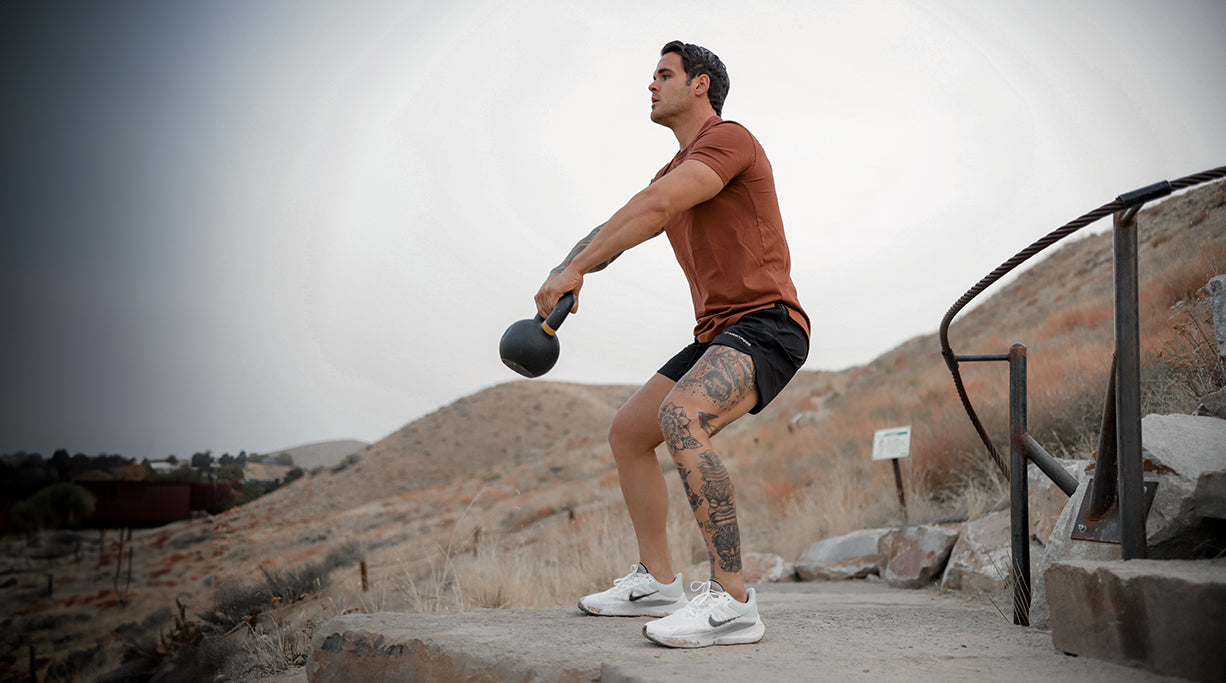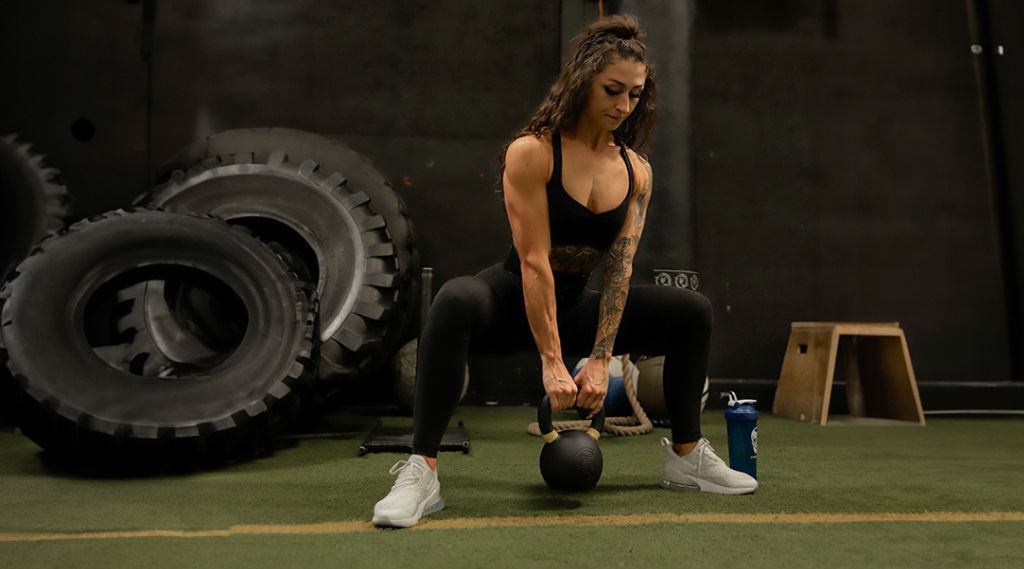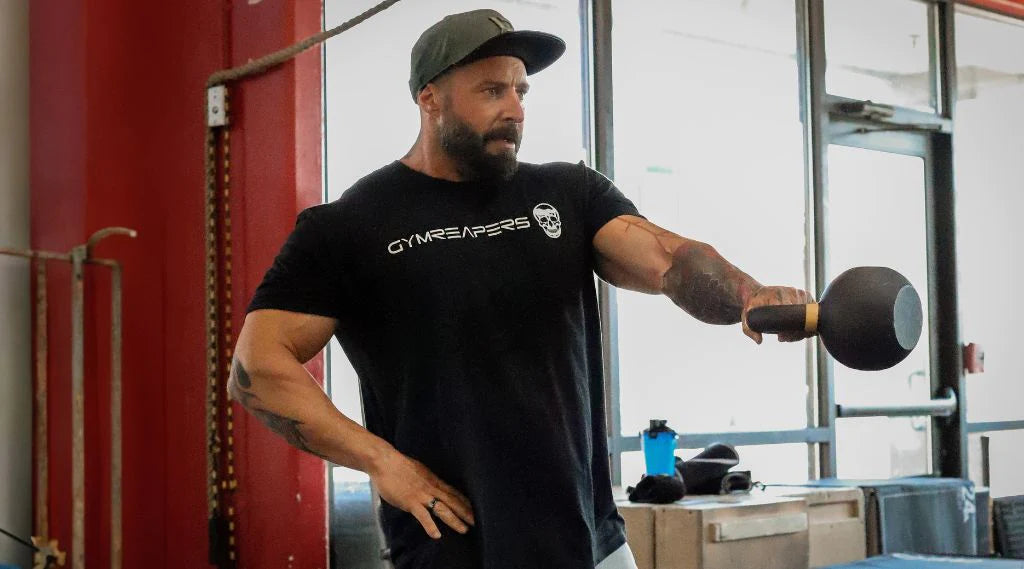As a strength coach, I’m a big fan of programming kettlebell back exercises to help my athletes develop bigger and stronger back muscles.
In this article, I will guide you through each of these kettlebell back exercises and provide you with a sample 4-week workout that you start implementing today. Here are the 10 best kettlebell back exercises:
- Kettlebell single-arm row
- Kettlebell chest supported row
- Kettlebell deadlifts
- Kettlebell single-leg RDL
- Kettlebell pullover
- Kettlebell farmers carry
- Kettlebell alternating renegade row
- Kettlebell swing
- Kettlebell clean
- Kettlebell back extensions
Key Takeaways
- Kettlebells can be used for a variety of back exercises where the back is working to stabilize the upper body or as a prime mover in a rowing motion.
- Training your back with kettlebells can improve your power output and strength level, and encourage hypertrophy (muscle growth).
Anatomy of the Back Muscles

The muscles used during back exercises are:
1) Latissimus dorsi (lats). The lats are responsible for internal rotation, adduction of the shoulder (bringing the arms back to center), and extension of the shoulder (bringing the arms back behind the body).
2) Erectors (Erector Spinae and Spinalis). The erector spinae is responsible for extension and side-to-side bending of the back.
3) Multifidus. The multifidus is responsible for extension and side-to-side bending of the back.
4) Rhomboids (rhomboids major and minor). The rhomboids are responsible for retraction of the shoulder blades (squeezing them together) and holding them in place.
5) Trapezius (traps). The trapezius is responsible for elevation, depression, and retraction of the shoulder blades.
6) Teres major (a small muscle near the shoulder blade). The actions of the teres major are internal rotation, extension, and adduction of the shoulder joint.
7) Biceps brachii. The biceps brachii performs elbow flexion and supination (rotation of the forearms).
Depending on the type of row, pull, or exercise there will be a different type of back muscle contraction. Vertical rows will involve the lats, biceps, and teres major, horizontal rows will increase back thickness and involve the traps, rhomboids, and lats, and diagonal rowing motions will target the teres major and lats. Other back exercises recruit the stabilizer muscles of the back including the erectors, spinalis, multifidus, and lats.
Benefits of Training the Back With Kettlebells
The benefits of training the back muscles with kettlebells include:
Variety Of Exercises To Target Back Musculature.
There are numerous exercise variations that you can perform with kettlebells to strengthen your back muscles. Exercises like deadlifts, cleans, and farmer’s carry can strengthen the back stabilizers, whereas exercises like renegade rows, chest-supported rows, and kettlebell single-arm rows can strengthen rowing of the back.
Ideal For Strength, Hypertrophy, And Power Development.
The ergonomic design of the kettlebell allows you to focus on strength, hypertrophy (muscle growth), and power when designing your workouts. When using a dumbbell, it is difficult to perform exercises like the clean or the kettlebell swing to promote power and athleticism. Kettlebells are ideal for explosive movements for power development, as well as heavier movements that will strengthen and grow your back muscles.
Safer To Perform And Encourage Injury Prevention.
The kettlebell design makes it more accessible and easier to use, especially for those with movement restrictions. Performing back exercises can also strengthen the structures of the back and improve posture, making you more resilient and resistant to injury.
10 Best Kettlebell Back Exercises
The top 10 kettlebell back exercises are:
1. Kettlebell Single Arm Row
As a bodybuilder and powerlifter, single-arm kettlebell rows have always been a staple exercise in my workouts to strengthen my back and reduce muscle imbalances.
How to do Kettlebell Single Arm Row
- Position yourself off to one side of a bench and hold a kettlebell on the side furthest from the bench.
- Plant the knee and hand closest to the bench on the bench for stability. Your torso should be parallel with the floor and the arm holding the kettlebell should be straight.
- Initiate the movement by driving your elbow back until it is at a 90-degree angle and in line with your torso.
- Return the rowing arm to the fully extended position to complete the repetition.
Pro Tip
To increase the range of motion of the movement and intensity of the contraction you can let the shoulder roll forward as you straighten your arm between reps and really emphasize driving the shoulder blade back as you row the weight toward you.
2. Kettlebell Chest-Supported Row
Kettlebell chest-supported rows are a great horizontal row option for upper back isolation because having your chest supported minimizes the involvement of secondary muscle groups that could otherwise help you “cheat” the movement.
How to do Kettlebell Chest-Supported Row
- Lay face down on a 45-degree incline bench with your chest firmly planted on the bench and your head hanging off the end.
- Holding onto two kettlebells, row towards your lower chest/abdomen bringing your elbows in line with your torso.
- Focus on squeezing the armpits and shoulder blades together at the top to get a maximal contraction.
- Extend the elbows and return the kettlebells to the starting position.
Pro Tip
At the top of each repetition, control and slowly lower the weight back down to increase time under tension and encourage better muscle growth.
You can also use this as a burnout exercise by doing alternating single arm reps and then once you’ve achieved 8 reps on each side, do two arm reps until complete exhaustion.
For example: x 8 each side @60% then AMRAP with both arms.
3. Kettlebell Deadlifts
Kettlebell deadlifts are going to give you the most bang for your buck by targeting the entire back, as well as the glutes and hamstrings.
Kettlebell deadlifts are the strongest movement for targeting your back muscles, so use them as an opportunity to train your back with heavier loads.
How to do Kettlebell Deadlifts
- Stand over the kettlebell with your feet hip-width apart.
- Let the arms hang as long as possible while sitting the hips back to load the glutes and hamstrings.
- Build as much tension as possible in your upper back by focusing on squeezing the armpits shut.
- Grab the corners of the kettlebell with both hands and engage your core to keep your spine neutral.
- Push with your legs to initiate the movement off the floor and then use your glutes and hamstrings to bring your hips back underneath you to stand tall.
- In a controlled fashion, push the hips back and let the kettlebell come back to the floor.
Pro Tip
Focus on keeping the kettlebell close to your body throughout the movement by engaging your back muscles; this will also reduce the strain on the lower back and your risk of injury.
4. Kettlebell Single-Leg RDLs
Kettlebell single-leg RDLs are great for developing single-leg strength while improving the total stability and strength of the upper back muscles.
How to do Kettlebell Single-Leg RDLs
- Hold a kettlebell in one hand and shift your weight onto the opposite leg.
- Keeping the arm with the kettlebell straight, initiate the movement by pushing the hips back and letting the un-loaded leg kick back behind you for balance.
- As you sit back into your hips, allow your chest to approach the floor and lower the kettlebell to the middle of your shin.
- Extend at the hips and return to a standing position to complete the rep.
Pro Tip
Keep your back engaged to maintain a neutral spine throughout the movement, prevent your shoulders from rounding forwards, and keep the kettlebell traveling along your leg (rather than further away from your body).
5. Kettlebell Pullover
Kettlebell pullovers are a diagonal rowing motion that targets the teres major and lats in a unique way, making them one of my favorite exercises to keep in my programming.
How to do Kettlebell Pullover
- Firmly place your upper back on the side of a bench so that your body is perpendicular to the bench.
- Bridge up off the bench until the hips and torso are completely parallel to the ground.
- Have your feet firmly planted on the ground with the knees bent at 90 degrees.
- Hold the kettlebell with both hands, keep your arms straight, and position the kettlebell over the upper abdomen/lower chest to start.
- At a controlled pace, lower the kettlebell behind your head until the arms are straight above your head.
- Using your lats, pull the kettlebell back to the starting position over the upper abdomen/lower chest to complete the repetition.
Pro Tip
The kettlebell pullover is an extremely light, low-stress movement, so it is best trained with higher repetitions.
Here is an example of how you could program high-repetition kettlebell pullovers: 3 sets of 20-30 repetitions @50%.
6. Kettlebell Farmer’s Carry
The kettlebell farmer’s carry is great for developing grip strength while improving the stabilizer muscles in the back that are responsible for posture.
How to do Kettlebell Farmer’s Carry
- Hold a kettlebell in each hand.
- Maintain an upright posture with the shoulder blades retracted (squeezed together).
- Walk forward while maintaining an upright posture and a level gaze.
- Walk for the desired amount of distance.
Pro Tip
Keep the kettlebells from resting on your thighs as you walk to ensure your upper back is doing its job throughout the entire movement.
7. Kettlebell Alternating Renegade Row
The kettlebell alternating renegade row encourages total body stability and improves rowing strength because it requires you to maintain a plank-like position as you row the kettlebell toward you.
How to do Kettlebell Alternating Renegade Row
- For this exercise, you will grab the handles of two kettlebells either shoulder width apart or a bit wider out.
- From this position, you will lower yourself until you are almost touching the ground.
- You will then push the ground away from you until your elbows are at complete extension.
- At complete extension, you will row one of the kettlebells while driving the elbow back.
- Then you will row the opposite arm.
- Repeat the push up then the rowing motions for the desired amount of repetitions.
- During this exercise, make sure that your hips don’t drop or shift excessively.
Pro Tip
If you feel limited by your ability to perform the push-up rather than the rowing portion of this movement, then remove the push-up and focus on the row itself.
8. Kettlebell Swing
Kettlebell swings are a compound movement that strengthens the muscles that stabilize the back and improves the explosiveness of the lower body muscles.
How to do Kettlebell Swing
- Stand with your feet a bit further than shoulder-width apart.
- Grab the corners of the kettlebell with each hand.
- Hinge at your hips and push the kettlebell back between your legs.
- Focus on loading the hips and the hamstrings.
- Snap the hips forward and let the kettlebell explode forward in front of you.
- Try not to use your shoulders to raise the kettlebell up, and avoid letting the kettlebell travel above shoulder level.
- Pull the weight back between your legs forcefully to complete the repetition.
- Repeat these steps for multiple repetitions.
Pro Tip
You can change the nature of this movement by standing over a band while tying the band to the head of the kettlebell. The implementation of a band will make this movement more elastic and explosive.
9. Kettlebell Clean
Kettlebell cleans are a great bang for your buck exercise by improving total body movement while strengthening the back, glutes, hamstrings, triceps, and core.
How to do Kettlebell Clean
- Stand with your feet slightly wider than hip-width apart.
- Hold a kettlebell between your legs with one hand.
- Load your glutes and hamstrings while hinging back.
- Snap your hips forward while letting the kettlebell glide up, as you aggressively jump and shrug the weight up.
- Let the kettlebell roll back into your wrist.
- Let the kettlebell fall back between your legs and then repeat the previous steps for the desired amount of repetitions.
Pro Tip
Focus on keeping the kettlebell close to you throughout the entire movement by activating your back muscles. If you allow the kettlebell to travel too far away from you, it will crash on your wrist when you receive it in the racked position.
10. Kettlebell Back Extensions
Kettlebell back extensions can increase back thickness and stability. These are one of my favorites to program since they are so easy to load up.
How to do Kettlebell Back Extensions
- Securely fasten your feet to the leg lock of the back extension.
- Hold a kettlebell in both your hands to make this exercise more difficult.
- Start with your knees straight and your torso upright.
- Lower your torso until completely bent. Your body should be making an “L” shape.
- Pull yourself back by pulling your heels into the leg locks to return to the starting position.
Pro Tip
During kettlebell back extensions you are at an advantage from a leverage standpoint. For this reason, you can really load up this exercise with minimal risk.
Sample Back Workout Routine With Kettlebells

Here is a sample week-to-week kettlebell back workout that you can implement:
Week 1
- Monday
- Kettlebell deadlifts: 3 x 5 @75%
- Kettlebell single-arm rows: 3 x 8 each side @60%
- Kettlebell back extensions: 2 x Failure
- Thursday
- Kettlebell cleans: 4 x 10 @60%
- Kettlebell pullovers: 4 x 12 @50%
- Kettlebell chest supported rows: 4 x 15 @50%
Week 2
- Monday
- Kettlebell deadlifts: 4 x 5 @75% + 5-10 lbs
- Kettlebell single-arm rows: 3 x 8 each side @60% + 5-10 lbs
- Kettlebell back extensions: 3 x Failure @30-40% + 5-10 lbs
- Thursday
- Kettlebell cleans: 4 x 10 @60% + 5-10 lbs
- Kettlebell pullovers: 4 x 12 @50% + 5-10 lbs
- Kettlebell chest supported rows: 4 x 15 @50% + 5-10 lbs
Week 3
- Monday
- Kettlebell deadlifts: 4 x 5 @75% + 5-10 lbs
- Kettlebell single-arm rows: 3 x 8 each side @60% + 5-10 lbs
- Kettlebell back extensions: 3 x Failure @30-40% + 5-10 lbs
- Thursday
- Kettlebell cleans: 4 x 10 @60% + 5-10 lbs
- Kettlebell pullovers: 4 x 12 @50% + 5-10 lbs
- Kettlebell chest supported rows: 4 x 15 @50% + 5-10 lbs
Week 4
- Monday
- Kettlebell deadlifts: 4 x 5 @75% + 5-10 lbs
- Kettlebell single-arm rows: 3 x 8 each side @60% + 5-10 lbs
- Kettlebell back extensions: 3 x Failure @30-40% + 5-10 lbs
- Thursday
- Kettlebell cleans: 4 x 10 @60% + 5-10 lbs
- Kettlebell pullovers: 4 x 12 @50% + 5-10 lbs
- Kettlebell chest supported rows: 4 x 15 @50% + 5-10 lbs

Kettlebells are ideal for my dynamic back exercises, since they are ergonomically built to do movements such as cleans, snatches, and swings and for strength and hypertrophy movements like different row variations.













Leave a comment
All comments are moderated before being published.
This site is protected by hCaptcha and the hCaptcha Privacy Policy and Terms of Service apply.